Woodland Plants
|
 |
Cocky Apple (Planchonia
careya)
This is a very
important tree to Aboriginal people around Townsville. Called Calendar
plant it tells people with its flowers when it is fishing time for
barramundi and when turtles are fat and ready to eat. Bark is also used
to make belts and dilly bags. Boomerangs are made out of the timber.
|
|

|
Moreton Bay Ash (Corymbia tessellaris)
Common across the
coastal landscape preferring soils the moist side of dry. It is
distinguished by its tessellated ‘sock’.
|
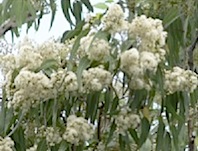 |
Coastal Bloodwood (Corymbia
clarksoniana)
This tree
has brownish-grey tessellated or scaly bark on the trunk,
branches and branchlets.
|
 |
Sandpaper Fig (Ficus
opposita)
Scrapings
of inner bark from the stem and the roots are boiled in water. The
liquid is cooled, strained and taken frequently in small doses. This is
an excellent remedy for diarrhoea and is also used as eyewash. The
small fruit can be eaten when ripe (red to brown) and is a favoured
food of many birds. The leaves are used as sandpaper on wooden tools.
|
 |
Red Ash or Soap Tree (Alphitonia
excelsa)
The leaves of these
trees are used as soap when crushed with water to make lather. Leaves,
roots and bark are used for medicinal purposes for sore eyes, upset
stomach and headaches. Leaves are also used to wrap meat, which is
cooked in an open fire. The ash of the burnt timber can be mixed with
water to apply to ringworms and skin disorders.
|
 |
Silver's Wattle (Acacia
holosericea)
There are many traditional uses of Acacias. The leaves and
immature green pods of Silver's Watte are used as bush soap. The wood
can also be used for spear shafts. A preparation made from the tree's
foliage is used as a medicinal bath, while the bark is used to treat
wounds and headache. The seeds from the Acacia holosericea are edible
and contain nutritional value.
|
 |
Peanut Tree (Sterculia
quadrifida)
The seeds from the peanut tree can be eaten raw and taste
similar to raw peanut. The inner bark was used by Aboriginal people for
weaving baskets, to make string, rope, nets and fishing lines.
An infusion made from bark of the Peanut Tree can be used to treat sore
eyes. Leaves can be used to treat stingray, stonefish and other wounds.
|
 |
Macaranga (Macaranga
tenarius)
Macaranga is a pioneering species that tends to establish
in disturbed natural areas and can be a good ally in shading out exotic
species when rehabilitating native bush. It has large heart shaped
leaves with a stem that joins the underside of the leaf 1cm from the
leaf edge.
|
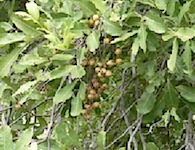 |
Tuckeroo (Cupaniopsis
anacardioides)
Common
to coastal areas where it is often found behind sand dunes and in vine
thickets. Tuckeroo is hardy and salt tolerant. The larvae of about 10
species of the Lycaenid family of blue butterflies are known to feed on
the leaves.
|
 |
Lolly Bush (Clerodendrum floribundum)
This is an important
plant for making firesticks with the stem also used for making pipes.
Roots are like parsnip to eat, but the fruit is inedible (poisonous).
Young leaves can be
crushed and boiled in water; the liquid cooled and strained and used as
a lotion on scaly or itchy skin and sores.
|
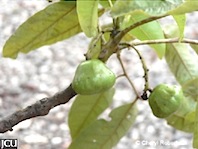 |
Burdekin Plum (Pleiogynum
timorense)
The Burdiken Plum is one of the more popular Aboriginal
bush tucker plants for its edible fruit. Fruit removed from the tree
should be stored to ripen for several days in a dark, moist place
including in the ground. The fruit varies in taste and can be quite
tart depending on ripeness, soils and the growing season.
|
 |
Sea Almond (Terminalia catappa)
A favourite tree of Red-tailed Black Cockatoos (Calyptorhynchus
banksii) for the ‘fruit’ and a great shade tree for everyone else.
|
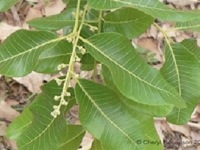 |
Mango Bark (Canarium
australianum)
A common tree in
woodlands around Townsville. The fruit/drupe is eaten by Torres Strait
Pigeons and other birds.
|
Coastal and Fringe Dwellers
|
 |
Screw Palm (Pandanus whitii)
The soft leaf base is chewed to relieve pain of sore
throat, mouth and tongue. The leaf base is also eaten raw and contains
carbohydrates. The white leaf stem base is chopped, boiled in water,
the liquid cooled and strained then used as a wash or dropped into red
or infected eyes. Leaves are used extensively for fibre crafts to make
baskets and mesh bags. The seeds (fruit kernels) are eaten raw, being
tasty and high in oil content. Good walking tucker. The white cabbage
is used to make a green dye and antiseptic packing for wounds
|
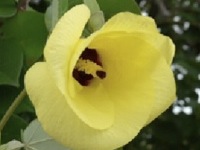 |
Beach Hibiscus (Hibiscus
tiliaceus)
The wood of the
Hibiscus tree is used to make woomeras, spears, fire-sticks and for
carvings. An infusion made from the inner bark and sapwood is used as
an antiseptic to treat boils and wounds and the strips of the inner
bark are used for binding wounds and sometimes tied around the head to
treat headache. The bark can also be used to make string, rope, fishing
lines and nets. The roots, flowers and young leaves are edible.
|
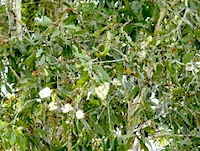 |
Red Tea Tree, Red Paperbark (Melaleuca
dealbata)
This is a paperbark that
tolerates salt water. With any paperbark you can dig down to find fresh
water. It has very strong wood that is very slow to break down so has
many uses for tools.
|
 |
Beach Wattle (Acacia
crassicarpa)
A small to medium tree
to about 8 metres high. Chiefly found in Eucalypt woodland and scrub in
coastal areas. It has strongly falcate phyllodes (curved leaves) from
11 to 20 cm long, with about 7 veins more prominent than the rest. The
woody seed pods are prominently striated and are 2.5-3.5 cm wide.
|

|
Native
Ebony (Diospyros geminata)
A small slender tree
with a stem diameter of about 15 cm. When properly ripe the edible soft
red pulp of the small fruit is quite sweet. Torres Strait Pigeons and
other birds are attracted to the fruit.
|

|
Grey
Mangrove (Avicennia marina)
Dry old
timber is burnt and the black ash is mixed with seawater to form a
paste. This is applied daily to infected sores, ringworm, boils and
other skin disorders and is considered to be a very effective
treatment. Leaves and stems are used to relieve marine stings and
bites. The timber is used to make shields and boomerangs.
|

